
Oct 02•5 min read
Introducing Web3 to Early Music Ensembles

Context
Last Spring I had the wonderful opportunity to address a group of musicians who make one of my favorite kind of music, Early Music. I had been requested to introduce the web3 to a few Early Music Ensembles among the best in Europe, as this was part of the Innovation Lab at the excellent “EEEmerging Program”.
I had been approached after participating in the unique Karajan Music Tech Conference, a few weeks before.
Since I did not know whether these musicians had any idea about our subject matter, and I wanted to adapt to their actual situation, I first sent a private survey* to the attendees, via the organization, so I could have a real catch on what was their present experience on the web, and to see what they actually knew about Web3, NFTs, and DAOs… I keep their anonymous answers which are revealing of the lights and shadows of what the Internet user experience has become in the past years.
Then I prepared my keynote talk , well aware that my audience was a ver y sensible one, yet not acquainted with the upcoming Internet.
Before starting my presentation, I had the privilege to get to know what some of them were up to at that moment in terms of projects and how they were using the web to connect with their audiences. Prisma, Cembaless, and Cantoría are the three ensembles that provided me my first learning of the session (and you know how much I like learning!). First, they had adapted to the limitations imposed by Covid restrictions beautifully, creating new experiences for their closest communities, also from their special new venues they were trying to reach new audiences via streaming… Just to Moreover, they were using all the social media they could and even considering making new contents for the new ones.
But stop, was this as effective as they wanted? These groups have their community managers and actual teams of professionals creating wonderful audiovisuals which they share on YouTube, for example. Now, although it is unclear whether this approach to promotion is really effective to bring public to their performances, this is definitely not a source of income for them. Anyway, exposure on the web helps them get the support from public institutions via different subsidies.
My reflection: in Europe culture is depending ever more in the institutional support, and this is a difficult situation in a scenario of crisis, so these artists need to find new ways to connect with their audiences directly. There is a lot they can offer: artistry and authenticity are the landmark of Early Music, and the openness to explore and the flexibility to create all kind of formats for their performances can help them thrive in the next web.
Once introduced in their world, it was my time to introduce them the web3, NFTs and DAOs.

Web3
The upcoming Internet where users will be able to exchange value P2P (peer to peer), sending and paying directly without intermediaries, and with the security of having all transfers and transactions settled on a public ledger thanks to blockchain tech. This is not science fiction, it is already happening, and will get adopted in the next years worldwide for all kind of items, products, services…
How can this be useful for artists like musicians?
NFTs
It is important to understand that Non Fungible Tokens bring property to the web: they are representations of items which provide ownership to the creator of the token, the individual who mints the NFT (and who is identified uniquely by his/her digital wallet). So if you have something that you consider valuable you can ‘tokenize’ it, and send it or sell it...

How could you use NFTs as a classical musician?
DAOs
So you have valuable items that you decide to tokenize… How can you sell them? You need to communicate this to your fans and followers. Yet, on the web 2.0, you never sold them anything, just promoted. Now, your admiring audience needs to become a community of clients willing to engage with your creative process.
A Decentralized Autonomous Organization is a type of organization that can derive in a business thanks to technology which can automate certain activities (treasury, governances…) and make it possible for communities to become actual businesses.
To build a DAO may be sound too challenging for a beginner on the web3, but you can decide in a mission (you may already have what moves your audience to follow you), and start building a community with the spirit of a DAO is possible while you keep learning about how it works. There is no rush… these are early days for this technology.

Conclusion
To wrap up, Let say that the session was long and intense. It was maybe too much for many of the attendees who were just discovering the change of paradigm coming up on the web, with all these new options so difficult to believe and understand.
Up until that moment these ensembles had been investing in promotion only on web 2.0 platforms, so I had first to recommend to evaluate if that really worked, and also to consider what if they could start making real business online with their art. My final point was that learning more about the web3 could be a good investment instead of putting all the efforts in keeping up with time-consuming web 2.0 platforms.
I would like to know what these groups really did with all this information, and if it had a real impact in their projects management. I am keeping in contact with the organizers of this very special Innovation Lab in Centre Culturel de Rencontre d'Ambronay (France). They know I am always available to provide updates and further information… and, of course, I am looking forward to having the chance to meet again.
Georgina Mauriño
Author-illustrator, Co-founder and Project Lead at Smartists, built on Stacks and secured by Bitcoin.
